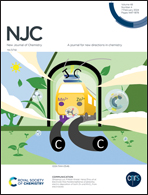The hydrophobic collapse of thermoresponsive polymer poly(N-vinyl caprolactam): a new class of biocompatible solvents†
Abstract
Deep eutectic solvents (DESs) provide a greener approach to reduce the toxicity of ionic liquids (ILs) when altering the behaviour of polymers. DESs have extraordinary properties such as high solubilising abilities, easy preparation, low volatility, good thermal stability, and cost effectiveness, making them suitable for wider applications in biomedical research. DESs can be used for modulating the behaviour of thermo-responsive polymers (TRPs) to provide successful hybrid functionality very near or at room temperature to achieve better stability. The current study is an attempt to achieve this and demonstrates that the presence of choline chloride : lactic acid, 1 : 2 (CC : LA), betaine : lactic acid, 1 : 2 (BET : LA), proline : lactic acid, 1 : 1 (PRO : LA) and urea : lactic acid, 1 : 2 (U : LA) as DESs can change the performance of a thermoresponsive polymer poly(N-vinylcaprolactam) (PVCL). The thermoresponsive behaviour of PVCL was investigated in this study using a variety of techniques, including steady-state fluorescence, Fourier-transform infrared (FTIR) spectroscopy, and UV-visible spectroscopy. Additionally, the LCST values of PVCL were also examined by temperature dependent dynamic light scattering (DLS) which showed a regular decrease in the presence of DES. Dynamic light scattering was also used to better understand the PVCL's aggregation behaviour in the DES environment. Our results show that DESs are generally ionic or polar protic in nature and that they promote hydrophobic interactions among the biopolymeric chains by providing a hydrophobic environment and significantly promoting the hydrophobic collapse of PVCL. It was observed in this study that the structure of DESs plays a major role in altering the lower critical solution temperature (LCST) of PVCL. Our results shows that U:LA provides the least hydrophobic environment due to its polar nature and that BET:LA exerts the most pronounced extent. The intramolecular hydrogen bonding interactions among urea molecules lead to its lower interactions with the surrounding PVCL polymer and the absence of hydrogen bonding in the betaine moiety favours the intermolecular interactions with PVCL and results in a more prominent decrease in the LCST values of the polymer. All DESs successfully modulated the LCST of PVCL through the exclusion of water molecules around the polymer and thus facilitated faster agglomeration. Notably, the LCST of BET:LA reached 27 °C. This study provides us with a new approach for drug carrier applications.



 Please wait while we load your content...
Please wait while we load your content...